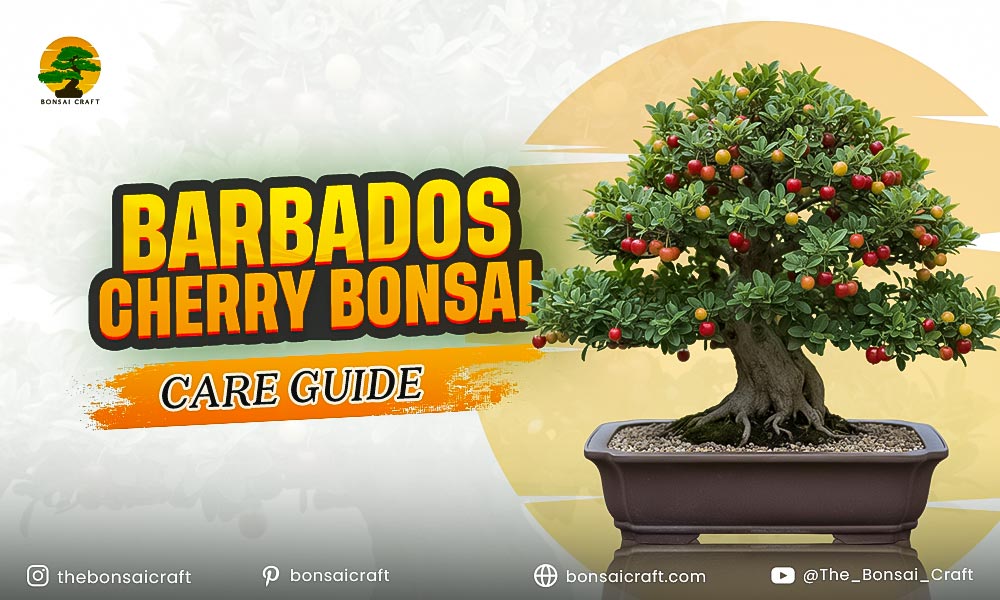
The Barbados Cherry Bonsai is a stunning addition to any collection, offering vibrant flowers and a delicate tree structure that captures attention. Its unique appearance, combined with its manageable size, makes it an excellent choice for bonsai enthusiasts of all levels. Whether you’re a seasoned grower or a beginner, caring for a Cherry Bonsai can be a highly rewarding experience. This guide will walk you through all the essentials of Barbados Cherry Bonsai care, from planting to pruning, ensuring your tree thrives and adds beauty to your home or garden.
Why Barbados Cherry Bonsai Is a Great Choice for Enthusiasts
The Barbados Cherry Bonsai (Malpighia emarginata) is a tropical shrub native to the Caribbean, known for its compact growth and striking appearance. Its small, glossy leaves and delicate pink or white flowers make it an attractive option for bonsai cultivation. Moreover, its bonsai cherry tree form adds a touch of elegance to any space.
Beyond aesthetics, the Barbados Cherry Bonsai tree has practical benefits. It is relatively easy to grow, adaptable to various environments, and offers a unique look that sets it apart from more traditional bonsai species like pine or maple. If you are wondering how to grow this vibrant bonsai Barbados cherry tree, this guide will provide all the tips and techniques to ensure successful growth.
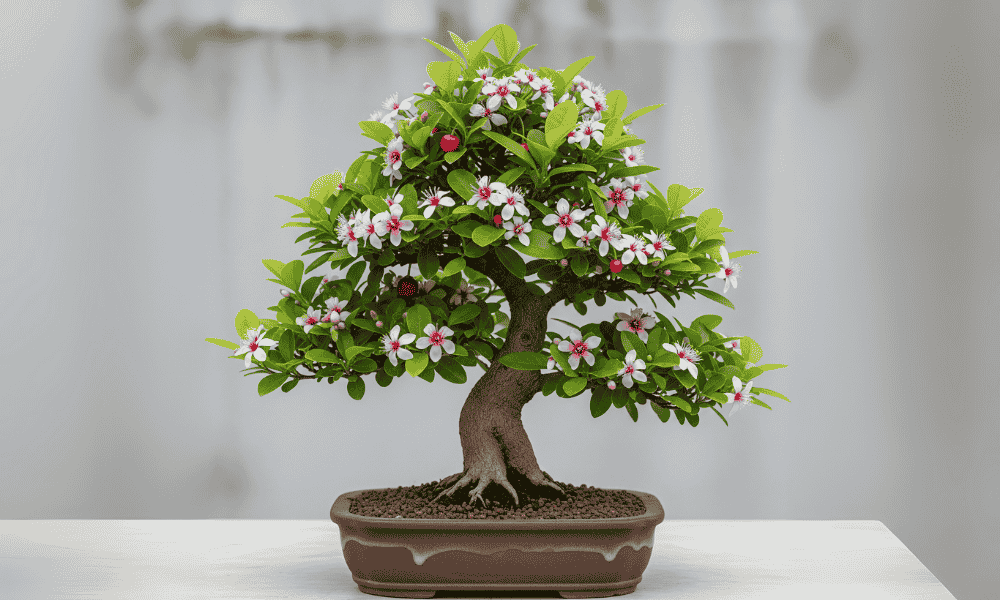
Barbados Cherry Bonsai Care: Essential Steps
Barbados Cherry Bonsai care requires well-draining soil, moderate watering, and bright, indirect light. Pruning and shaping are essential for maintaining a compact size and healthy growth.
Growing a Barbados Cherry involves a series of steps, from planting and soil selection to regular pruning and proper care. By following the guidelines below, you can cultivate a healthy, thriving bonsai Barbados cherry tree in your home or garden.
1. Selecting the Right Soil
The Barbados Cherry Bonsai requires well-draining soil to thrive. A mix of akadama, pumice, and lava rock is ideal, as it allows water to flow through while retaining the necessary nutrients. The soil should be light and airy, which helps the tree’s roots receive adequate oxygen.
2. Choosing the Right Container
When selecting a pot for your Barbados Cherry Bonsai tree, ensure that it has proper drainage holes. The container should be large enough to accommodate the root system but not so large that it leads to overwatering. A slightly shallow pot works well to encourage root development and compact growth.
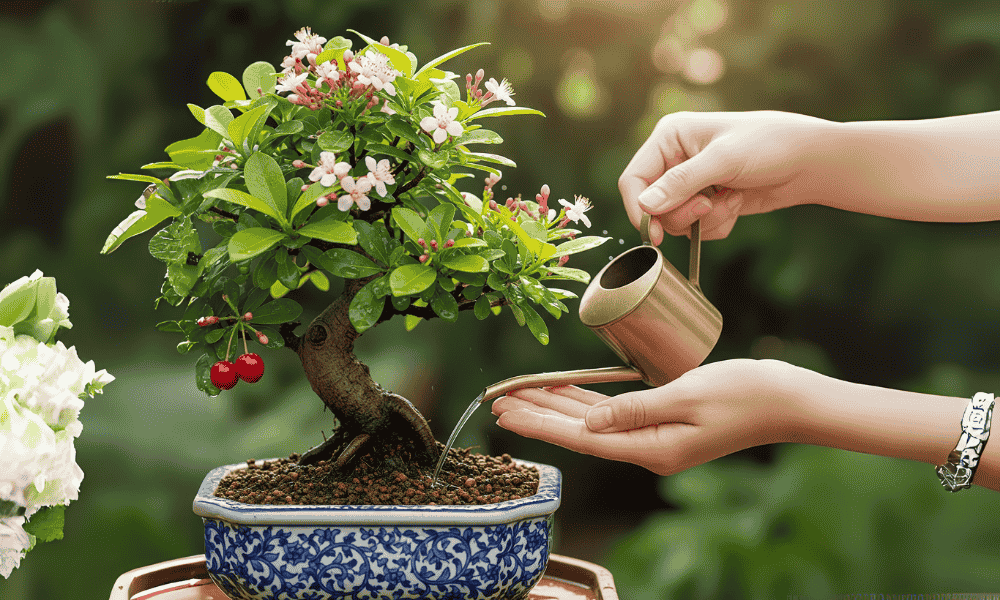
3. Watering Your Barbados Cherry Bonsai
Proper watering is key to the success of your bonsai cherry tree. The Bonsai Barbados Cherry prefers moderate watering — the soil should be kept slightly moist, but not soggy. Allow the top layer of soil to dry out between waterings, but make sure the root system doesn’t dry out completely.
During the growing season, water the tree more frequently, and reduce watering in winter when the tree is in its dormant phase.
4. Sunlight Requirements
Bonsai Barbados Cherry trees need plenty of bright, indirect light to thrive. Place your bonsai cherry tree near a window where it can get at least 4-6 hours of sunlight daily. If growing indoors, make sure the light is not too harsh, as it can burn the leaves.
In areas with harsh sunlight, consider placing the bonsai under a sheer curtain or near a shaded spot outdoors during the hotter months.
5. Fertilizing Your Barbados Cherry
Fertilization is an essential part of Barbados Cherry Bonsai care. Use a balanced, liquid fertilizer diluted to half-strength during the growing season. Feed your bonsai Barbados cherry tree every 2-4 weeks to ensure it gets the nutrients it needs to grow and bloom.
Avoid fertilizing in the winter months when the tree is not actively growing.
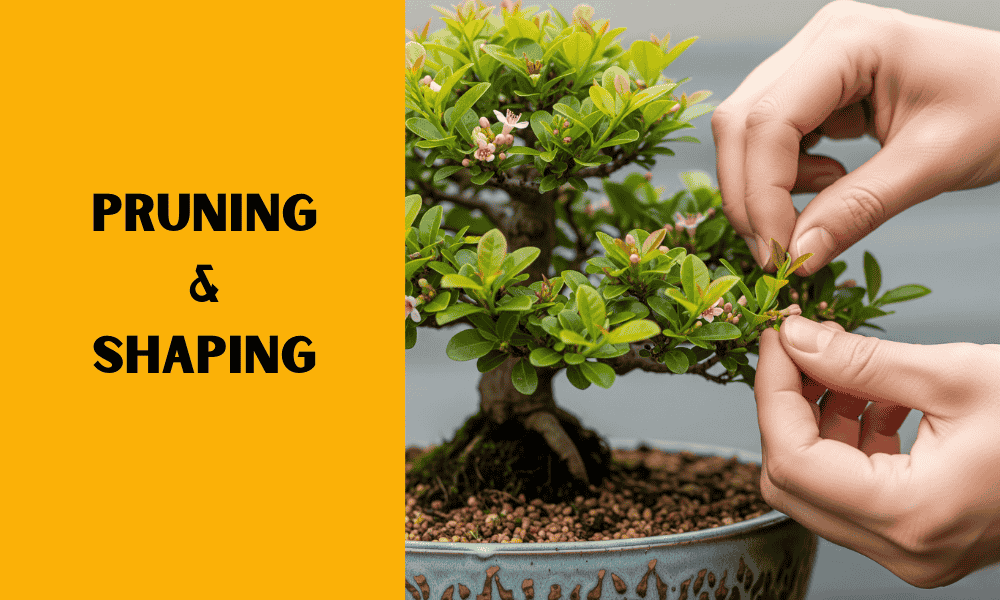
6. Pruning and Shaping Your Barbados Cherry
Regular pruning is necessary to maintain the desired shape of your Bonsai Barbados Cherry. Pinch back the new growth to promote branching, and remove any dead or diseased wood. As with other bonsai trees, you can wire the branches to guide their direction, but be gentle to avoid damaging the delicate stems.
Special Considerations for Different Barbados Cherry Bonsai Types
Dwarf Barbados Cherry Bonsai
The dwarf Barbados cherry bonsai is an excellent choice for those who want a smaller, more compact tree. This variety of Barbados Cherry Bonsai grows more slowly and remains smaller in size compared to the standard version. You will need to provide similar care but pay extra attention to pruning to ensure it stays compact and doesn’t grow too large.
Weeping Barbados Cherry
The weeping Barbados cherry is a beautiful variant known for its cascading branches and graceful shape. To maintain the characteristic weeping form, prune the central trunk regularly and allow the branches to cascade freely. Ensure that the tree gets plenty of light to prevent leggy growth, which can distort the weeping shape.
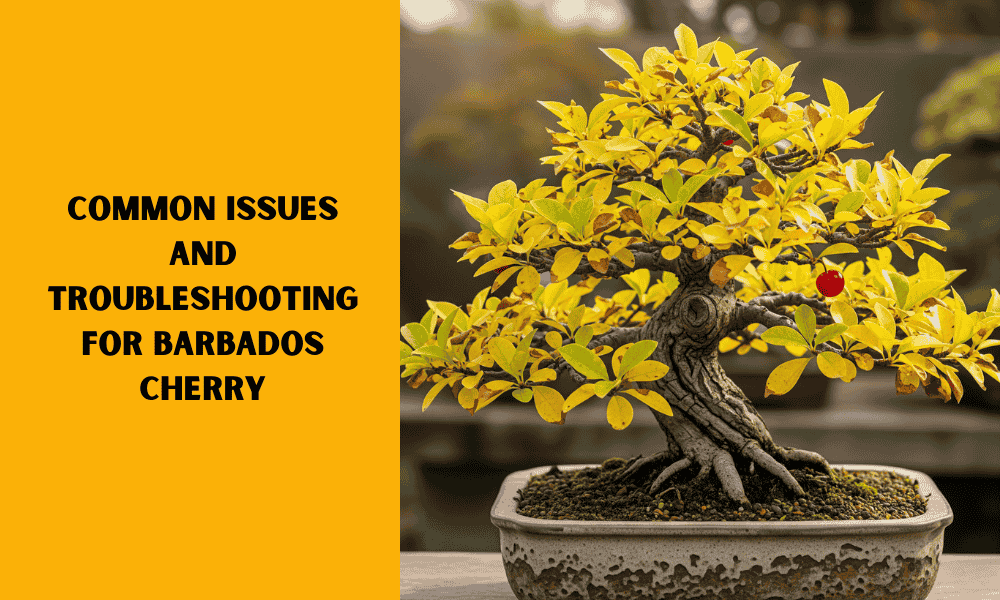
Common Issues and Troubleshooting for Barbados Cherry
Common issues with Barbados Cherry include yellowing leaves, poor flowering, and pest infestations. Ensure proper care and address problems promptly to keep the tree healthy.
While the Barbados Cherry Bonsai is relatively low-maintenance, it can still face a few challenges. Here are some common issues and how to troubleshoot them:
1. Yellowing Leaves
Yellowing leaves can be a sign of overwatering, underwatering, or nutrient deficiencies. Check the soil moisture, and ensure the tree is not sitting in stagnant water. If the problem persists, adjust your watering schedule and consider adding a nutrient-rich fertilizer to promote healthy growth.
2. Poor Flowering
If your bonsai cherry tree is not flowering, it may not be receiving enough light or may be over-pruned. Ensure the tree is placed in a sunny spot and that it’s getting adequate nutrients. Also, avoid cutting back too many flower buds during pruning.
3. Pests
Barbados Cherry Bonsai trees are susceptible to common pests such as aphids, spider mites, and scale insects. Regularly inspect the tree for pests, especially during the growing season. Treat infestations with insecticidal soap or neem oil, and prune any affected areas.
Re-potting Your Barbados Cherry Bonsai
Re-potting is an essential part of Barbados Cherry Bonsai care, ensuring the tree has enough room to grow and that the soil remains fresh. Plan to re-pot your bonsai cherry tree every 2-3 years to maintain healthy roots and encourage new growth.
Here’s how to re-pot your Barbados Cherry Bonsai:
- Carefully remove the tree from its pot and gently untangle the roots.
- Trim any long or damaged roots, leaving the main root structure intact.
- Fill the new pot with fresh bonsai soil, placing the tree in the center and ensuring it is stable.
- Water the tree thoroughly after re-potting, and allow it to settle in its new home.
Conclusion: Barbados Cherry Bonsai Care Tips
Caring for a Barbados Cherry Bonsai is a fulfilling and rewarding experience. Whether you’re growing a dwarf Barbados cherry bonsai, a weeping Barbados cherry bonsai, or a classic bonsai cherry tree, the essential care practices remain the same: well-draining soil, moderate watering, proper light, and regular pruning. By following these steps, your Barbados Cherry Bonsai will thrive and continue to impress with its vibrant flowers and graceful appearance.
Expert Tip: Be patient. Bonsai trees, including the Barbados Cherry Bonsai tree, take time to develop into their full beauty. Regular maintenance and careful attention to their needs will ensure a long-lasting and beautiful addition to your bonsai collection.
FAQs
How do I care for a Barbados Cherry Bonsai?
To care for a Barbados Cherry Bonsai, ensure it receives bright, indirect light, water it moderately, and prune it regularly to maintain its shape. Use well-draining soil and fertilize every few weeks during the growing season.
What are the different types of Barbados Cherry Bonsai?
There are several varieties of Barbados Cherry Bonsai, including the dwarf Barbados cherry bonsai, known for its smaller size, and the weeping Barbados cherry bonsai, which features cascading branches.
How often should I water my Barbados Cherry Bonsai?
Water your Barbados Cherry Bonsai when the top inch of the soil feels dry. Ensure the soil is slightly moist but not waterlogged to avoid root rot.
Why are the leaves on my Barbados Cherry Bonsai turning yellow?
Yellowing leaves can indicate overwatering, underwatering, or nutrient deficiencies. Check the soil moisture and adjust your watering habits accordingly. You may also need to fertilize your tree.
How do I prune a Barbados Cherry Bonsai?
To prune a Barbados Cherry Bonsai, cut back new growth to promote branching and maintain the desired shape. Be sure to remove any dead or damaged branches, and avoid cutting too much of the flower buds.
